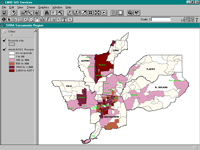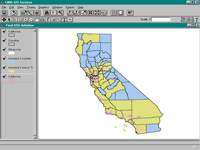|
The Magazine for
Esri Software Users
|
|
|
GIS Works for Labor Information Analysts
By Monica Pratt, ArcUser Editor
California's $1.65 trillion economy, as measured by the gross state product in 1999, is the largest and most diverse economy in the United States and can be ranked with the economies of major industrial nations. Collecting and analyzing data on the labor force powering this economy is a complex task. In the State of California, labor information is collected, analyzed, and reported by the Labor Market Information Division (LMID) of the Employment Development Department (EDD). In the last four years, the LMID began using GIS as a tool for the Division's analysts.
Far from being an abstract discussion topic, labor market information affects the decisions of individual workers, business owners, and government policy makers at all levels. Information describing and predicting labor supply and demand influences choices individuals make regarding the careers they pursue, where they look for jobs, and how they obtain education and training. Employers starting or relocating businesses need information on the business climate and skill pool available in various areas of the State to evaluate possible sites. Government decision makers creating policies that promote employment and prosperity in the State need current and accurate labor information.
Taming Challenging Analytical Tasks
The use of GIS by state transportation or environmental management departments has traditionally been more widely known. Many elements in the labor equation-employers and employees, workers and training providers, government offices and recipients of government services-have spatial relationships, and GIS enhances analysis of these elements. Many elements in the labor equation-employers and employees, workers and training providers, government offices and recipients of government services-have spatial relationships, and GIS enhances analysis of these elements.
Research analysts at LMID use ArcView GIS to reveal relationships between data sets that are not discernable when the data is displayed in tables or charts. LMID analysts map socioeconomic factors and produce hard-copy maps for use in the Division's regular publications and for projects requested by clients both inside and outside State government. LMID has used GIS for tasks such as defining economic regions in the State, analyzing industry clustering, relating the locations of welfare recipients to job opportunities, assisting in administering the State's food stamp program, maximizing federal funding allocations, and helping to equitably distribute State funds to local programs.
Optimization-determining the best solution given jurisdictional and other constraints-is a type of analysis that in many cases would not be feasible in the absence of GIS. A project LMID worked on involving identifying areas of substantial unemployment (ASU) by census tract illustrates the use of GIS in arriving at optimized solutions.  The ASU areas that were to be selected needed to have the maximum possible number of unemployed persons and satisfy three additional constraints mandated by the Job Training Partnership Act (JTPA), a federally funded employment and training program. The constraints included a requirement that selected areas should have an unemployment rate of 6.5 percent or more, have a total population of 10,000 persons or more, and that individual census tracts should maintain contiguity with other ASU census tracts. Applying these constraints to California's 5,858 census tracts translated into more than 200 billion possible solutions. The ASU areas that were to be selected needed to have the maximum possible number of unemployed persons and satisfy three additional constraints mandated by the Job Training Partnership Act (JTPA), a federally funded employment and training program. The constraints included a requirement that selected areas should have an unemployment rate of 6.5 percent or more, have a total population of 10,000 persons or more, and that individual census tracts should maintain contiguity with other ASU census tracts. Applying these constraints to California's 5,858 census tracts translated into more than 200 billion possible solutions.
While this was far too many solutions to consider individually, thematically mapping the data made the task doable. The selection criteria were translated into a mathematical model and tracts were ranked based on the model. Selected tracts were checked for contiguity and noncontiguous (orphaned) tracts were identified. Tracts immediately adjacent to orphaned tracts were evaluated to determine which ones were the best candidates (i.e., most conforming to the criteria) to "bridge" the orphan tracts to other qualifying tracts. The combined areas that included orphan and bridge tracts were reranked based on the model and rechecked for continuity to arrive at an optimized solution. This complex and highly spatially dependent process would not be practical to carry out manually but was easily handled using an Avenue script developed by LMID staff.
Benefits Inside and Outside LMID
GIS services from LMID are available by contract or on an ad hoc basis. As a State agency, LMID's charge-for-service policy applies to reimbursable costs, which lowers the cost to the customer. The Trade and Commerce Agency and Economic Strategy Panel, the California Work Opportunity and Responsibility to Kids (CalWorks) program, and the EDD Workforce Development Branch are some the Division's major customers.
The Division uses data it generates and also has agreements to use data from other agencies. These data sharing agreements protect the confidentiality of the data. LMID shares the results of its analysis with agencies of the federal government, as well as local governments, and publishes reports on the State's labor market, occupational outlook, and labor supply for specific industries. Sharing data and information avoids redundant work by government agencies and promotes better communication between them.
A Useful Tool
Mary Mahoney, a research specialist with the Economic Trends Analysis Team at LMID, helped pioneer the use of GIS at the Division. She says GIS was initially used for a few projects and there wasn't a master plan to adopt GIS. Mahoney, along with Research Manager Steve Saxton, Research Specialist Janet Austin, and Research Analyst Scott Christman, implemented use of GIS at LMID and have built up GIS expertise in the organization through membership in the Sacramento ArcView Users' Group. They also formed an in-house user group that supports occasional users of GIS at EDD as well as the core group of users at LMID. Saxton and Christman no longer work in LMID, but they both continue to use GIS and Christman is an active member of both user groups. Staff members at LMID spend hours outside of work developing and maintaining GIS skills through taking classes, reading books, and practicing with the software.
Though GIS is a very useful tool, LMID analysts don't use GIS full time, so improvements in ease of use with the latest release of ArcView GIS have really benefited them. Says Austin, "GIS has a secure foothold in LMID, having proven its benefit in data analysis and some areas of program administration. Because the learning curve for GIS software has flattened so considerably with each new release of ArcView GIS, in the next couple of years GIS could become as common on analysts' desktops as spreadsheet and word processing programs are today."
The Future of GIS at LMID
LMID's success using GIS for complex analysis activities and delivering quality products in a timely manner has helped feed demand for these services. Maintaining current GIS capabilities involves preserving and increasing GIS expertise in the Division. Expanding the use of GIS by the Division would be enhanced by the integration of location information in data collection and management systems. Access to high-quality and relevant data has to be balanced with protecting the confidentiality of individuals, employers, and small areas. Current plans to expand the use of GIS to other LMID workers include supplying area consultants, off-site LMID staff, with BusinessMAP PRO.
Austin sees a larger role for GIS at LMID. "The expansion of GIS in LMID will be limited only by our ability to be creative and assertive in broadening the application of GIS technology to employment and training programs. In particular, I think GIS holds tremendous potential for consensus building and as a gateway for individualized service delivery. This will mean expanding the use of the Internet and stand-alone service-providing programs. Policy makers themselves cannot be expected to have insights as to the applications of GIS; we must strive on our customers' behalf."
For more information on the use of GIS by the LMID contact
Mary Mahoney
Economic Trends Analysis Team
Labor Market Information Division
Employment Development Department
7000 Franklin Boulevard, Suite 1100
Sacramento, California 95823
Tel.: 916-262-2225
E-mail: lmid.mmahoney@edd.ca.gov
| |